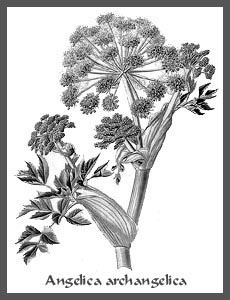 |

 NamesThe word angel comes from the Greek agghlos meaning announcer. Some of its folk names are Angelica, Archangel, Archangelica officinalis, Garden Angelica, and Masterwort.
CultivationAngelica does best in moist, slightly acid loam in a cool, partially shaded location.Plant seeds in the summer just after ripening for they lose their germinating ability. Sow a pinch of seeds 1/4 inch deep in intervals of 2 1/2-3 feet apart for the plant will eventually grow to 4-7 feet high. After they sprout, in about three weeks, thin to leave only the strongest in each location. In the second year if the stalks are cut back the roots will send up shoots that can be transplanted. Roots should be dug during the fall of the first growing season while they are still tender. During the second season the leaves and stalks can be harvested. The stalks should be cut in the spring before flowering.
HistorySince ancient times Angelica has been held in the highest of esteem for its virtues as a protection against contagious deseases, for its abilities to purify the blood and just about every conceivable malady.In Eastern Prussia it is still the custom to carry Angelica flowers into the towns chanting an ancient pagan ditty that even the singers do not understand. The words and tune are taught in childhood and have been passed down through the centuries. Some say Angelica received its name when during the plague a monk was said to have a vision from an angel that this herb would cure the plague. It was also dubbed the Root of the Holy Ghost because of the belief that it warded one against evil spirits and against the enchantment of witches.
Culinary UsesThe stems, roots and seeds of Angelica are used in confectionary and flavouring. Candied Angelica comes in wide flat strips and is cut in diamond shapes to use with other candied fruit for decorative purposes.It is also used in liqeurs and cordials such as Vermouth and Chartreuse.Because of their aromatic qualities the dried leaves are used in the preparation of hop bitters.
Spiritual Properties and Uses in MagicAngelica's energy can be utilized in many ways. It is used in herbal 'tobacco' formulas and can enable one to communicate with the angelic realm by inducing visions.When grown in the garden it will protect the home from negative outside influences. The leaves can be scattered in an area to purify also. Worn as an amulet it protects the wearer against witchcraft. Among some American Indian tribes the root was carried for good fortune when gambling. Wearing angelica as an amulet will help you to follow the path of your heart with faith and certainty. Add it to your bath, it has the power to remove any curses, spells or hexes that have been cast, it will strengthen your aura and bring joy to your senses. When burned as an incense it purifies, protects and heals and is used in this way in exorcism rituals. Burning angelica in a smudge will purify and protect anything in its vicinity. Angelica is said to be a gift from the angels and it's greatest strength is the gift of temperance. The capacity to rise above our troubles and the patience to wait serenely for the outcome of events. It opens up the heart chakra and allows us the follow our chosen path with peace and clarity.
Healing Properties and UsesAngelica is used in most herbal stomach remedies and as an aid to digestion. If you want to use it by itself do so sparingly for it is not recommended for continuous applications. Although it is benefical it should not be used for longer than four weeks.Eating the roots candied or steeped in vinegar is excellent during a fast to prevent infection. Infusing the fresh plant (100g of herb in 1l of water) and added to the bath relieves stress. Mix an infusion of angelica with wine against the common cold and lung ailments. The root of angelica is good in salves for rhuematic pains and skin disorders. A dried root decoction of angelica is said to remove the taste for alchohol, drink two cups of tea per day for this purpose. The root strengthens the stomach, alleviaes flatulance, disinfects the intestine, and treats intestinal colic. It is best to prepare a cold infusion of the roots: pour one cup of cold water over one teaspoon of angelica root, let stand in a container for several hours, then boil for two minutes, steep two more minutes, strain off, and serve. Do not consume more than two cups every day. When it is used in tincture or infusion it has the ability to raise the body temperature and aids in digestion which makes it an excellent remedy for the elderly. When using as a tincture the doses are ten to thirty drops, four times each day.
CautionsAngelica is a uterine stimulant and should not be used by pregnant women internally (a bath would be fine though).It be used by people who have hot conditions such as infections, fevers, or feelings of excess warmth in the body. Diabetics should not use angelica as it tends to increase the sugar in the blood. Do not exceed the recommended amounts for it can adversely affect the heart, respiration and blood pressure. Although angelica is a stimulant if taken in very small doses, it is becomes a depressant at a higher dosage. Do not attempt to collect angelica yourself from the wild unless you possess real botanical expertise, angelica can be confused with poison hemlock. The roots are only safe to consume after they have been dried first. Some Canadian tribes ate the fresh roots for suicidal purposes.


|
 |
 |


